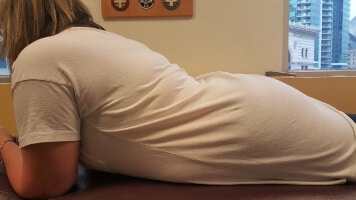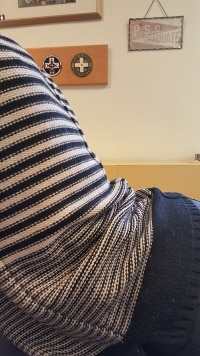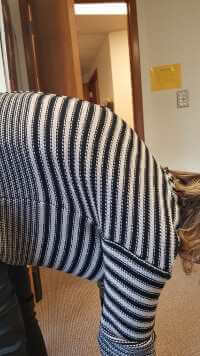Lumbar Stenosis- A primer for patients.





Lumbar Stenosis
Stenosis is a spinal condition in which the holes, called foramen, between the vertebrae close down, crushing the delicate nerves that travel through them. This can be caused by any number of causes, from tumors to discs to genetics, but the primary cause is from degeneration of the discs in the spine.
When these nerves get compressed, any number of symptoms can result. Often, symptoms will get worse slowly over time. Most often, symptoms will be on one side of the body or the other.
Symptoms include pain, numbness and weakness, and in the case of stenosis patients, and gets worse with walking or standing. Unlike the typical lumbar disc injury patient, the symptoms often lessen or disappear with sitting or leaning forward. Most people with spinal stenosis cannot walk for a long period of time, and then slowly regain their abilities after resting.
Legal caveat: If you are experiencing: difficulty or poor balance when walking, or problems controlling urine or bowel movements, please call your doctor immediately. This article is not written for you… go to the ER, or you regular doctor immediately.
Unfortunately, many people who are reading this have already been diagnosed with the condition, looking for a possible treatment. Unfortunately, just as stenosis comes on slowly, it doesn’t go away quickly, either, unless you opt for surgery, which we call the “Roto Rooter method”.
The reason I’m writing this article is to offer a new way to look at lumbar stenosis, and how it occurs, and how to identify patients BEFORE they reach the neverending circle of pain and dysfunction stage of this condition.
I’d like to start with what I call the “typical patient”.
TYPICAL PATIENT
It’s written in the literature that patients can be any sex, and across body types, with patients usually showing signs in their mid 50’s. Lumbar Spinal Stenosis: A Definitive Guide, by Peter F. Ullrich, Jr., MD, but it’s been my clinical experience that this occurs far more frequently in men. Sorry, guys.
The signs of stenosis are related directly to pressure on nerves. Motions or actions that increase the pressure on the nerves increases the patient’s pain levels, and those that relieve it are the ones that patients adopt. Usually, patients find it best to slightly lean forward , gapping the hole at the rear of the vertebrae. This often results in the stooped, shuffling posture we often see in older men, as a longer stride would force extension of the lumbar spine and compression of the nerve roots. These patients slowly develop more problems, as they are compressing the disc, and often slowly “grind to a halt”, where they can’t lean forward without hurting, and can’t lean back without hurting, either. Eventually, lying down is the only comfortable position, and every other position causes or increases their pain. The condition results in the loss of exercise, usually leading to added weight gain. The literature is now showing a significant tie between chronic pain and depression, as well. These once active patients slowly dissolve into the “Damned if you do, damned if you don’t.” situation, when it comes to moving.
However, as we age it’s clear that while symptoms show up later in life, it’s usually due to issues that start earlier in life. In my opinion, this occurs much earlier, in our teen years.
THE LUMBAR SPINE
Sparing the reader a basic anatomy lesson, we’re going to talk about the spine from a structural integrity standpoint. Basically, on its own, the spine is unstable in the vertical position. Hundreds of studies involving the cutting of various cadaver muscles show at what point the spine becomes unstable, and it’s appalling, in my opinion. (However, those opposable thumbs are hard to beat.) We as humans are forced to use the muscles that surround the spine, to support it. Terms such as “the core” are often used to describe these muscles: The abs, the extensors, the transverse abdominis. I like to include three more: the diaphragm, the pubococcygeus (Kegel), and the iliopsoas. The first two of these muscles are unique in that they are horizontal, and lend stability as being the top and bottom of the core group. The primary reason for writing this article however, is the iliopsoas.
The iliopsoas hold great esteem in the hearts of meat eaters: the cut of beef it yields is the revered filet mignon. It is internal for the entirety of its length, living unseen below the tissues of the body. It begins, or inserts, by attaching to the lumbar spine vertebrae and discs, running inferiorly (down) the leg, attaching to the femur. It is actually comprised of the psoas, which we described, and the iliacus, which runs along the inner border of our hip bone, looking like a tarp covering the inside bowl of a stadium, with the fibers going down the leg, eventually joining with the tendon of the psoas muscle.
Using the iliopsoas as a stabilizer of the lumbar spine is certainly possible, as seen with various studies: 1. 2. 3. and there’s many more.
THE PROBLEM
My postulation is this…. Wait for it……
MANY PATIENTS WHO OVERUSE THE ILIOPSOAS AS A STABILIZER EVENTUALLY DECAY THE LUMBAR SPINE TO THE POINT IT CAUSES SPINAL STENOSIS.
A good way to think of this method of stabilizing the lumbar would be to imagine five oranges (or grapefruit, if you prefer) in a row. It’s entirely possible to hold them in a row while using a compression load (squeezing them), but the slightest insult will disturb the line, allowing it to bend.
For anyone who is fortunate enough to have sailed a dinghy with an adaptable rig, you can imagine what would happen if you increased the downhaul of a babystay, directly down the front of the mast, it will increase the compression of the mast significantly, and force a bend in the spar. Now this is great for certain conditions, but not ALL of them. ( I seriously will never figure out when. Super light winds? Strong winds? Who knows.  If I ever won a sailboat race, I’d let you know.
If I ever won a sailboat race, I’d let you know.
Now, “back” to you….
This constant over-compression of the lumbar spine results in a slow grinding down of the discs in the spine, and results in an over-extension of the lumbar spine, which give the patient the look of a large, extended belly.
This belly is now not that different than that of a pregnant woman’s, and will result in a condition common to pregnant women called diastasis recti. It’s typically a football- shaped bump in between your “six pack muscles” , as the wall of the abdomen stretches out with the increased pressure from the internal organs, due to the increased curve of the low back.
Recently I have been testing my patients for an umbilical hernia ( your belly button). This is really just diastasis recti in another place on the anterior abdominal wall… it’s like a soft part of a bicycle tube, and pushes out.
It is this condition that triggered the need for this article. Diastasis recti is easy to spot, simply by having a patient do a small sit up from a supine position, and looking. Finding it is NOT a good thing… In fact, I feel it is the sign of a long-standing biomechanical problem. I have not been able to determine if by fixing the biomechanics that the diastasis recti would heal itself, but as it does repair on pregnant women, it should with the cases of hyperextension I see in practice.
FIXING THE PROBLEM
How then, do we go about alleviating this issue? There are two issues that must be addressed. The first is to elongate the iliopsoas. The second is to train the patient to use other muscles for stabilizing the low back.
STRETCHING THE ILIOPSOAS
The failure of other practitioners to achieve success with “psoas” stretching is the inability to, or unwillingness to, recognize that the iliopsoas muscle should be treated as a fully 3 dimensional object, with muscle fibers crossing not only the x, but y and z axes. Therefore, the muscle needs to be stretched around ALL THREE axes. (It is actually “theta x, y and z, meaning rotation around… sorry to get a little nerdy there) These exercises will soon be outlined in the “Self Help” section, under Psoas Stretching… or you can click here….https://dynamicclinic.com/finally-our-3d-stretching-of-the-iliopsoas-muscle-is-live-woot-woot/
STRENGTHENING THE LUMBAR SPINE
One of the best ways to stabilize the lumbar spine is to use the two horizontal muscles of the thorax to give stability to the low back: the diaphragm, and the pubococcygeus, or Kegel muscles. Diaphragmatic breathing is absolutely important, as it can stabilize the core each and every time we breathe. The Kegel use is very important from a neurologic standpoint, as its innervations is the same as that of the transverse abdominis, the most important “core” muscle of the torso. As much as I would love to go into detail about exercises for this, it’ll take more input from you, the reader, for me to further expound on these… it takes more work that I’d admit to get these articles written and published than I thought!
Chiropractic Services
